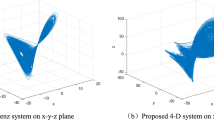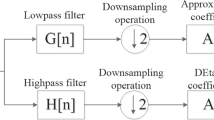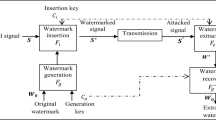Abstract
Due to the advancement of photo-editing software, powerful computers and high resolution capturing devices, it has become tough to prevent the digital image from tampering. So, in these days just by looking a digital image we cannot say whether it is a genuine or not. This is why digital image authentication, as well as restoration, has become the essential issues, especially when it is utilized in medical science, evidence of court, and forensic science. This paper proposes an effective self-embedding fragile watermarking technique for the digital image authentication as well as recovery. The watermark is generated by quantization, and block truncation coding (BTC) of each 2 × 2 non-overlapping block and embedded in three least significant bits (LSBs) of the corresponding mapped block. The recovery bits are derived from most significant bits (MSBs) of the host image, and the authentication bits are derived from recovery bits, the spatial location of pixels and watermark keys. Even if tempering rate is 50%, the reconstruction of tampered image is achieved with high peak signal-to-noise ratio (PSNR) and normalized correlation coefficient (NCC). The experimental results demonstrate that the proposed scheme not only outperforms high-quality recovery fidelity but also negotiate the blocking artifacts additionally it improves the accuracy of tamper localization due to the use of very small size blocks.
Access this article
We’re sorry, something doesn't seem to be working properly.
Please try refreshing the page. If that doesn't work, please contact support so we can address the problem.










Similar content being viewed by others
References
Bhatnagar G, Wu QJ, Raman B (2013) A new aspect in robust digital watermarking. Multimedia Tools Appl 66(2):179–200
Chang CC, Lin CY, Fan YH (2008) Lossless data hiding for color images based on block truncation coding. Pattern Recogn 41(7):2347–2357
Cox I, Miller M, Bloom J, Fridrich J, Kalker T (2007) Digital watermarking and steganography. Morgan Kaufmann
Delp EJ, Mitchell OR (1979) Image compression using block truncation coding. IEEE Trans Commun 27(9):1335–1342
Dhara BC, Chanda B (2004) Block truncation coding using pattern fitting. Pattern Recogn 37(11):2131–2139
Elshazly EH, Faragallah OS, Abbas AM, Ashour MA, El-Rabaie E-SM, Kazemian H, Alshebeili SA, Abd El-Samie FE, El-sayed HS (2015) Robust and secure fractional wavelet image watermarking. SIViP 9(1):89–98. ISSN: 1863-1711. https://doi.org/10.1007/s11760-014-0684-x
Franti P, Nevalainen O (1995) Block truncation coding with entropy coding. IEEE Trans Commun 43(2/3/4):1677–1685
Hartung F, Kutter M (1999) Multimedia watermarking techniques. Proc IEEE 87(7):1079–1107
He HJ, Zhang JS, Chen F (2009) Adjacent-block based statistical detection method for self-embedding watermarking techniques. Signal Process 89(8):1557–1566
Korus P, Dziech A (2013) Efficient method for content reconstruction with self-embedding. IEEE Trans Image Process 22(3):1134–1147
Lee TY, Lin SD (2008) Dual watermark for image tamper detection and recovery. Pattern Recogn 41(11):3497–3506
Lema M, Mitchell OR (1984) Absolute moment block truncation coding and its application to color images. IEEE Trans Commun 32(10):1148–1157
Nasir I, Weng Y, Jiang J, Ipson S (2010) Multiple spatial watermarking technique in color images. SIViP 4(2):145–154
Patra JC, Phua JE, Bornand C (2010) A novel dct domain crt-based watermarking scheme for image authentication surviving jpeg compression. Digital Signal Process 20(6):1597–1611
Peng F, Guo RS, Li CT, Long M (2010) A semi-fragile watermarking algorithm for authenticating 2d cad engineering graphics based on log-polar transformation. Comput Aided Des 42(12):1207–1216
Preda RO (2013) Semi-fragile watermarking for image authentication with sensitive tamper localization in the wavelet domain. Measurement 46(1):367–373
Qi X, Xin X (2011) A quantization-based semi-fragile watermarking scheme for image content authentication. J Vis Commun Image Represent 22(2):187–200
Qian Z, Feng G, Zhang X, Wang S (2011) Image self-embedding with high-quality restoration capability. Digital Signal Process 21(2):278–286
Singh D, Singh SK (2016) Dwt-svd and dct based robust and blind watermarking scheme for copyright protection. In: Multimedia Tools and Applications
Singh D, Singh SK (2016) Effective self-embedding watermarking scheme for image tampered detection and localization with recovery capability. J Vis Commun Image Represent 38:775–789. https://doi.org/10.1016/j.jvcir.2016.04.023. http://www.sciencedirect.com/science/article/pii/S1047320316300566
Singh D, Singh SK (2017) Dct based efficient fragile watermarking scheme for image authentication and restoration. Multimedia Tools Appl 76(1):953–977. https://doi.org/10.1007/s11042-015-3010-x
Singh D, Shivani S, Agarwal S (2013) Quantization-based fragile watermarking using block-wise authentication and pixel-wise recovery scheme for tampered image. IJIG 13(02):1340002(01)–1340002(11)
Singh D, Shivani S, Agarwal S (2013) Self-embedding pixel wise fragile watermarking scheme for image authentication. In: Intelligent interactive technologies and multimedia, pp 111–122. Springer, Berlin, Heidelberg, New York
Song C, Sudirman S, Merabti M (2009) Recent advances and classification of watermarking techniques in digital images Proceedings of post graduate network symposium
Song C, Sudirman S, Merabti M (2012) A robust region-adaptive dual image watermarking technique. J Vis Commun Image Represent. 23(3):549–568
Walia E, Suneja A (2014) A robust watermark authentication technique based on webers descriptor. SIViP 8(5):859–872
Wang S, Zheng D, Zhao J, Tam WJ, Speranza F (2014) Adaptive watermarking and tree structure based image quality estimation. IEEE Trans Multimedia 16(2):311–325
Wu Y, Coll DC (1991) Btc-vq-dct hybrid coding of digital images. IEEE Trans Commun 39(9):1283–1287
Wu M, Liu B (1998) Watermarking for image authentication ICIP (2), pp 437–441
Zhang X, Wang S (2008) Fragile watermarking with error-free restoration capability. IEEE Trans Multimedia 10(8):1490–1499
Zhang X, Wang S (2009) Fragile watermarking scheme using a hierarchical mechanism. Signal Process 89(4):675–679
Zhang X, Qian Z, Ren Y, Feng G (2011) Watermarking with flexible self-recovery quality based on compressive sensing and compositive reconstruction. IEEE Trans Inf Forensics Secur 6(4):1223–1232
Zhang X, Wang S, Qian Z, Feng G (2011) Reference sharing mechanism for watermark self-embedding. IEEE Trans Image Process 20(2):485–495
Zhang X, Wang S, Qian Z, Feng G (2011) Self-embedding watermark with flexible restoration quality. Multimedia Tools Appl 54(2):385–395
Zhu X, Ho AT, Marziliano P (2007) A new semi-fragile image watermarking with robust tampering restoration using irregular sampling. Signal Process Image Commun 22(5):515–528
Acknowledgements
The authors would like to thank Dr. Sushila Maheshkar, Department of Computer Science & Engineering, Indian Institute of Technology (ISM) Dhanbad - 826004, Jharkhand, India, for fruitful discussions and suggestions. The authors would also thank the anonymous reviewers whose valuable suggestion resulted in improving the quality of this paper.
Author information
Authors and Affiliations
Corresponding author
Rights and permissions
About this article
Cite this article
Singh, D., Singh, S.K. Block Truncation Coding based effective watermarking scheme for image authentication with recovery capability. Multimed Tools Appl 78, 4197–4215 (2019). https://doi.org/10.1007/s11042-017-5454-7
Received:
Revised:
Accepted:
Published:
Issue Date:
DOI: https://doi.org/10.1007/s11042-017-5454-7




